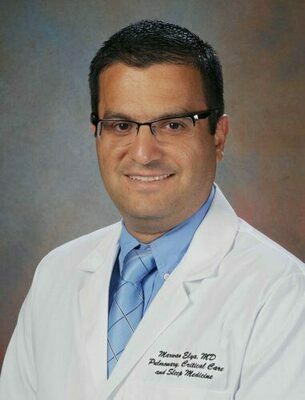Sleep Apnea And Stroke What You Need To Know To Live Healthy
 Dr. Marwan Elya
Dr. Marwan Elya
Medical Director of the McLeod Sleep Clinic
One in five adults suffer from some form of sleep apnea, a condition in which an individual repeatedly stops breathing throughout the night.
Individuals may have mild sleep apnea, characterized by five to 14 apnea episodes, or pauses in breathing; moderate sleep apnea, characterized by 15 to 29 episodes per hour; or severe sleep apnea, characterized by 30 or more episodes per hour.
Some episodes awaken the individual, significantly impacting the quality of sleep. Over time, untreated sleep apnea can lead to many serious conditions, including stroke.
The prevalence of sleep apnea is high in stroke patients, estimated to be between 50 to 70 percent. The most common type of sleep disordered breathing found after a stroke is Obstructive Sleep Apnea (OSA). Several studies have shown OSA as a strong risk factor for hypertension, or high blood pressure, one of the leading risk factors for stroke. Other stroke factors linked to OSA include coronary artery disease, heart failure and atrial fibrillation.
OSA is characterized by repeated collapse of the pharyngeal airway during sleep, resulting in reduced or complete cessation of airflow despite ongoing breathing efforts.
OSA affects 20 percent of males and 10 to 15 percent of females. The risk factors for OSA include obesity, male gender, aging, daytime sleepiness, hypertension, menopausal status, African American race, Chinese and Indian ancestry. Non-obese individuals are still at risk for OSA, accounting for 30 percent of patients who have the disorder.
Most patients with OSA come to the attention of their physician because they are complaining of daytime sleepiness, or the bed partner reports loud snoring, gasping, snorting, or interruptions in breathing while sleeping.
Other associated symptoms of OSA are irritability, awakening with dry mouth, awakening with a sensation of gasping, lack of concentration, morning headaches, impotence, frequent urination at night and depression.
Diagnosis
While snoring is common with OSA, not all people who snore have the disorder. Polysomnography (sleep study) is the gold standard diagnostic test when it is performed overnight in a sleep laboratory with a technologist in attendance.
During the sleep study the patient is connected to a variety of monitoring devices. The sleeping room is equipped with a camera and audio system. The heart rate, oxygen saturation, presence of snoring and airflow are monitored, among other parameters.
In some patients, the diagnostic evaluation may be performed at home without a technician in attendance.
Treatment
The most common and effective treatment for OSA is continuous positive airway pressure, or CPAP, which provides constant air pressure through a face mask to keep the individual’s airway open.
Timely prescription of the CPAP, ensuring compliance and eliminating obstacles, such as the need for different masks, are a very important component in the care of the sleep apnea patient. The CPAP has a memory card, and the information can be downloaded to document compliance and assess the adequacy of treatment.
Once the patient’s symptoms have resolved with the use of a CPAP, a long term follow-up plan should be established with annual assessment. More frequent visits may be needed if new issues arise. The purpose of annual visits is to monitor for new symptoms, machine problems (such as air leaks), and changes in body weight.
Although CPAP is the standard treatment for OSA, the sleep specialist can sometimes advise other alternatives, such as oral appliances and surgery. Also, in obese patients, weight reduction and exercise are advised.
Why is this important?
When an individual stops breathing, his oxygen level drops and his body releases a stress hormone in response. Because sleep apnea sufferers experience several apnea episodes each night, their adrenaline levels remain high and can lead to high blood pressure.
OSA is a common and serious sleep disorder. Untreated, sleep apnea can cause cardiovascular disease, memory problems, weight gain, impotence and headaches. Moreover, untreated sleep apnea may be responsible for job impairment and motor vehicle crashes.
McLeod Sleep Clinic
Located at McLeod Regional Medical Center, the McLeod Sleep Clinic offers comprehensive care diagnosing and managing sleep disorders in adults ages 18 and older.
The McLeod Sleep Clinic allows patients to consult with and undergo evaluation by a sleep specialist. Our physicians are board certified by the American Academy of Sleep Medicine and offer the highest quality specialty care for sleep disorders.
The McLeod Sleep Clinic treats the following sleep disorders: Sleep Apnea (Obstructive and Central), Narcolepsy, Restless Leg Syndrome, Shift Work/Circadian Rhythm Sleep Disorder, REM Behavior Disorder and Insomnia.
For patients interested in undergoing a sleep study in the comfort of their home, home sleep apnea testing (HSAT) is available for suitable candidates.
For more information, call (843) 777-5827.
Please support The Community Times by subscribing today!
 Loading...
Loading...
.jpg)
